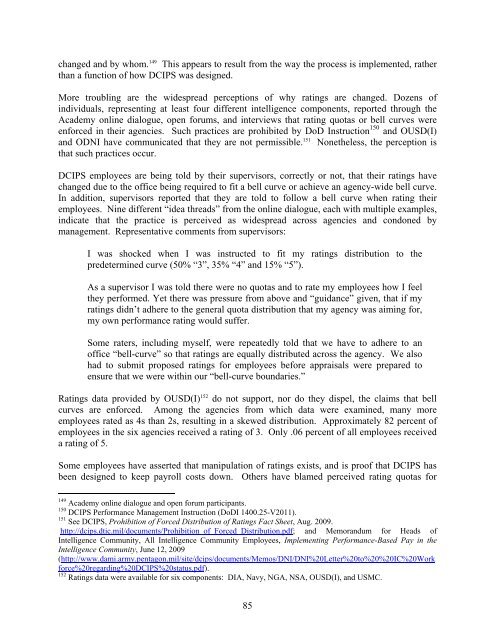Report - Government Executive
Report - Government Executive
Report - Government Executive
Create successful ePaper yourself
Turn your PDF publications into a flip-book with our unique Google optimized e-Paper software.
changed and by whom. 149 This appears to result from the way the process is implemented, rather<br />
than a function of how DCIPS was designed.<br />
More troubling are the widespread perceptions of why ratings are changed. Dozens of<br />
individuals, representing at least four different intelligence components, reported through the<br />
Academy online dialogue, open forums, and interviews that rating quotas or bell curves were<br />
enforced in their agencies. Such practices are prohibited by DoD Instruction 150 and OUSD(I)<br />
and ODNI have communicated that they are not permissible. 151 Nonetheless, the perception is<br />
that such practices occur.<br />
DCIPS employees are being told by their supervisors, correctly or not, that their ratings have<br />
changed due to the office being required to fit a bell curve or achieve an agency-wide bell curve.<br />
In addition, supervisors reported that they are told to follow a bell curve when rating their<br />
employees. Nine different “idea threads” from the online dialogue, each with multiple examples,<br />
indicate that the practice is perceived as widespread across agencies and condoned by<br />
management. Representative comments from supervisors:<br />
I was shocked when I was instructed to fit my ratings distribution to the<br />
predetermined curve (50% “3”, 35% “4” and 15% “5”).<br />
As a supervisor I was told there were no quotas and to rate my employees how I feel<br />
they performed. Yet there was pressure from above and “guidance” given, that if my<br />
ratings didn’t adhere to the general quota distribution that my agency was aiming for,<br />
my own performance rating would suffer.<br />
Some raters, including myself, were repeatedly told that we have to adhere to an<br />
office “bell-curve” so that ratings are equally distributed across the agency. We also<br />
had to submit proposed ratings for employees before appraisals were prepared to<br />
ensure that we were within our “bell-curve boundaries.”<br />
Ratings data provided by OUSD(I) 152 do not support, nor do they dispel, the claims that bell<br />
curves are enforced. Among the agencies from which data were examined, many more<br />
employees rated as 4s than 2s, resulting in a skewed distribution. Approximately 82 percent of<br />
employees in the six agencies received a rating of 3. Only .06 percent of all employees received<br />
a rating of 5.<br />
Some employees have asserted that manipulation of ratings exists, and is proof that DCIPS has<br />
been designed to keep payroll costs down. Others have blamed perceived rating quotas for<br />
149 Academy online dialogue and open forum participants.<br />
150 DCIPS Performance Management Instruction (DoDI 1400.25-V2011).<br />
151 See DCIPS, Prohibition of Forced Distribution of Ratings Fact Sheet, Aug. 2009.<br />
http://dcips.dtic.mil/documents/Prohibition_of_Forced_Distribution.pdf; and Memorandum for Heads of<br />
Intelligence Community, All Intelligence Community Employees, Implementing Performance-Based Pay in the<br />
Intelligence Community, June 12, 2009<br />
(http://www.dami.army.pentagon.mil/site/dcips/documents/Memos/DNI/DNI%20Letter%20to%20%20IC%20Work<br />
force%20regarding%20DCIPS%20status.pdf).<br />
152 Ratings data were available for six components: DIA, Navy, NGA, NSA, OUSD(I), and USMC.<br />
85













